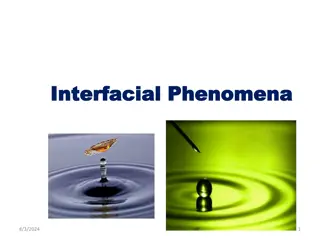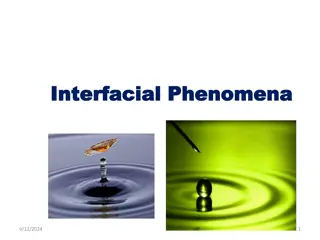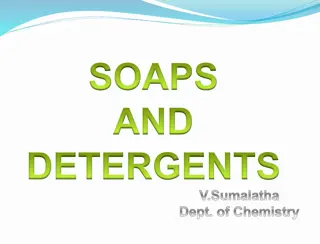Understanding Micelles: Key Concepts and Applications
This comprehensive guide delves into the world of micelles, covering topics such as hydrophilic versus hydrophobic substances, the formation and structure of micelles, how detergents work, their role in biological systems, and their applications in drug delivery and other aspects of biology. Learn about critical micelle concentration, lab activities, and more as you explore the intriguing realm of micelles.
Download Presentation

Please find below an Image/Link to download the presentation.
The content on the website is provided AS IS for your information and personal use only. It may not be sold, licensed, or shared on other websites without obtaining consent from the author. Download presentation by click this link. If you encounter any issues during the download, it is possible that the publisher has removed the file from their server.
E N D
Presentation Transcript
Micelles Center for Nanotechnology Education Version 010919
Outline Hydrophilic versus hydrophobic substances Micelles How detergents work Biological systems How micelles are used for drug delivery Other applications of micelles in biology Critical micelle concentration Lab activity
Hydrophilic versus Hydrophobic Some compounds naturally dissolve readily in water; these compounds are called hydrophilic, meaning they like water For example, table salt
Hydrophobic Materials Some compounds naturally do not dissolve readily in water; these compounds are called hydrophobic, meaning they dislike water For example, grease or oil
Detergents Detergents are a type of molecule that has a hydrophilic head and a hydrophobic tail. Part of an individual detergent molecule likes water and part does not. Two detergent molecules
Micelles Detergents (and some other molecules) spontaneously assemble into micelles when placed in water A micelleis a ball-like structure where the hydrophobic tails orient into the center of the ball and the hydrophilic heads orient outwards.
Aqueous Environment Hydrophobic Interior of Micelle Hydrophobic Tail Hydrophilic head
Micelles, Cont. Micelles form spontaneously because they are stable. Micelles are stable because the hydrophobic tails that do not like water are protected from water inside the sphere
Micelles, Cont. Micelles are small Micelles used for drug delivery (which we will discuss later) are often in the 10-30 nm range Micelle formation is an example where molecules spontaneously associate to form a nanoparticle
A Familiar Application of Micelles Detergents are familiar as cleaning agents so let s consider this application of micelles first How do detergents help clean our laundry?
Detergents Oils and greases are hydrophobic so they do not dissolve or mix with in water If clothing soiled with grease or oil is placed in water, the oil or grease is repelled by water and remains in the fabric But if detergent is added the oils and greases interact with the detergent micelles The oil or grease molecules move into the hydrophobic interiors of micelles
Detergents, Cont. The micelles interact with water because their surfaces are hydrophilic The oil or grease-micelles can be washed away from the clothing This video demonstrates the action of a detergent: https://www.youtube.com/watch?v=kpRbnLZX_dI
Applications to Biology Now that we have considered a familiar application of micelles in cleaning, let s consider how micelles can be applied in biology and biotechnology
Importance of Water in Biological Systems Life evolved in the ocean; all of life on earth is based on water Humans are about 50-70% water Cells are typically 70% water Therefore it is necessary to understand how chemicals interact with water when studying biology
Hydrophilic and Hyrdophobic Compounds that are hydrophilic readily dissolve in the watery environment of blood or cells or the gut Compounds that are hydrophobic do not dissolve in the aqueous milieu of organisms
Drug Delivery A major challenge is ensuring that drugs reach their target site inside a patient Consider, for example, a drug that is taken orally. Hydrophobic drugs pass through the gut without being absorbed -- they do not interact with the watery environment in the gut Also, the gut is filled with enzymes that break down food that is ingested. The same mechanisms that digest food also break down ingested drugs.
Drug Delivery, Cont. Hydrophobic drugs that are injected or delivered intravenously do not dissolve in the blood and so are not readily transported in the body
Drug Delivery, Cont. Micelles can be used to overcome the problems delivering drugs Drugs can be packaged inside micelles, much as grease or oil is surrounded by detergent micelles when doing laundry
Drug Delivery, Cont. Drugs packaged in micelles Are not broken down by enzymes in the gut Are readily transported into the cells that line the gut and hence enter into the body Are transported readily in the blood Can be targeted to sites in a patient Not all drugs are delivered in micelles but some are
Another Application of Micelles in Biology Micelle formation is essential for humans to absorb fat-soluble vitamins and lipid nutrients Bile salts are compounds made in the liver Bile salts allow ingested fatty acids to form micelles. This allows the intestine to absorb fatty acids that the body needs Micelles also allow the intestine to absorb lipid- soluble vitamins (A, D, E, and K) that are packaged into the micelles
Bile Salts In the absence of bile salts and the resulting micelles, essential lipid nutrients and vitamins pass through the intestine and are excreted without being absorbed Fotosearch Stock Photography and Stock Footage Royalty Free Images Liver
Critical Micelle Concentration, CMC Critical micelle concentration, is the concentration at which detergents (or other micelle-forming molecules) spontaneously assemble into micelles when they are placed in water. At concentrations below the CMC detergent molecules exist in the water as individual molecules.
CMC and Drug Delivery In drug delivery it is important that the CMC be as low as possible so that the micelles do not disperse when they are diluted in the body
Laboratory Activity You will experiment with a system that forms micelles, as a scientist might experiment when designing a drug delivery system Instead of a drug, you will use a dye -- the dye is visible and so it can be detected readily You will use a detergent that forms micelles when present at concentrations above its CMC
Basic Experiment Your basic experiment will allow you to estimate the CMC for your system Once you have estimated the CMC, time permitting, you can try to modify the CMC CMC is sometimes influenced by Temperature Added salts The type of detergent
Preparation for Basic Experiment Read the handout carefully Plan your work: What materials will you need? How will you label your beakers? How will you label your test tubes? How many filter papers will you need? How will you measure out the detergent How will you measure the amount of color in your samples? Your instructor may provide additional directions to prepare























